How to Choose the Right Warehouse Management System Without Losing Your Mind
2021-02-08

Choosing the right warehouse management system ensures more efficient warehouse and inventory management in distribution or manufacturing logistics, and on top of that, it generates added value for the business. What criteria should a business consider in order to find the right solution when choosing a warehouse management system?
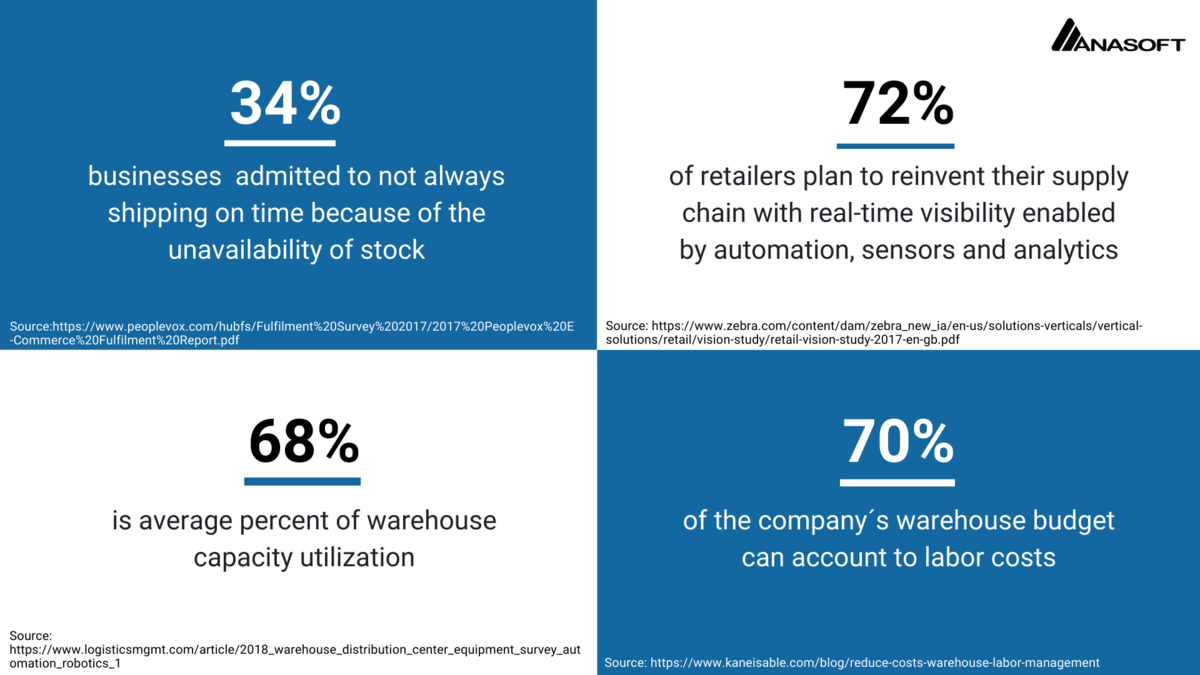
In a survey by Logistics Management, respondents reported increased use of warehouse management systems (WMS), additional automation, and greater use of metrics and advanced picking methods to cope with the challenges of a tight labor market, e-commerce growth and order fulfillment complexities. The number of respondents who used some type of warehouse management system (WMS) reached a new high of 93%.
A warehouse and inventory management system is one of the key software systems used by most businesses in retail, distribution, e-commerce and order fulfillment.
However, choosing the right system is not a trivial matter. A new online store, a distribution company planning to scale up business operations and a retailer expanding order volume and product range all face similar dilemmas when looking for a suitable solution for their warehousing, inventory and logistics processes.
Businesses in the early stages of digitalization and automation expect the following results from the implementation of a WMS system:
- acquiring detailed insight into ongoing supply operations,
- real-time access to inventory levels and movement,
- boosting performance of order picking and dispatching processes,
- and reducing error rate during order fulfillment.
On the other hand, businesses that are already working with a WMS or similar solution expect to extract added value from deployment of innovative software platforms. These platforms usually employ the latest technology such as digital twins, artificial intelligence and machine learning.
Cutting-edge technology is one reason these smart industry systems deliver more value. This includes intelligent labor management, automatic synchronization and coordination of warehousing operations and automation of administrative and financial processes, and their dynamic adaptation to consumer behavior and market changes. Furthermore, advanced solutions for intelligent warehouse and inventory management carry extended possibilities for horizontal and vertical value chain integration.
ANALYSIS OF PRIORITIES AND EXPECTATIONS
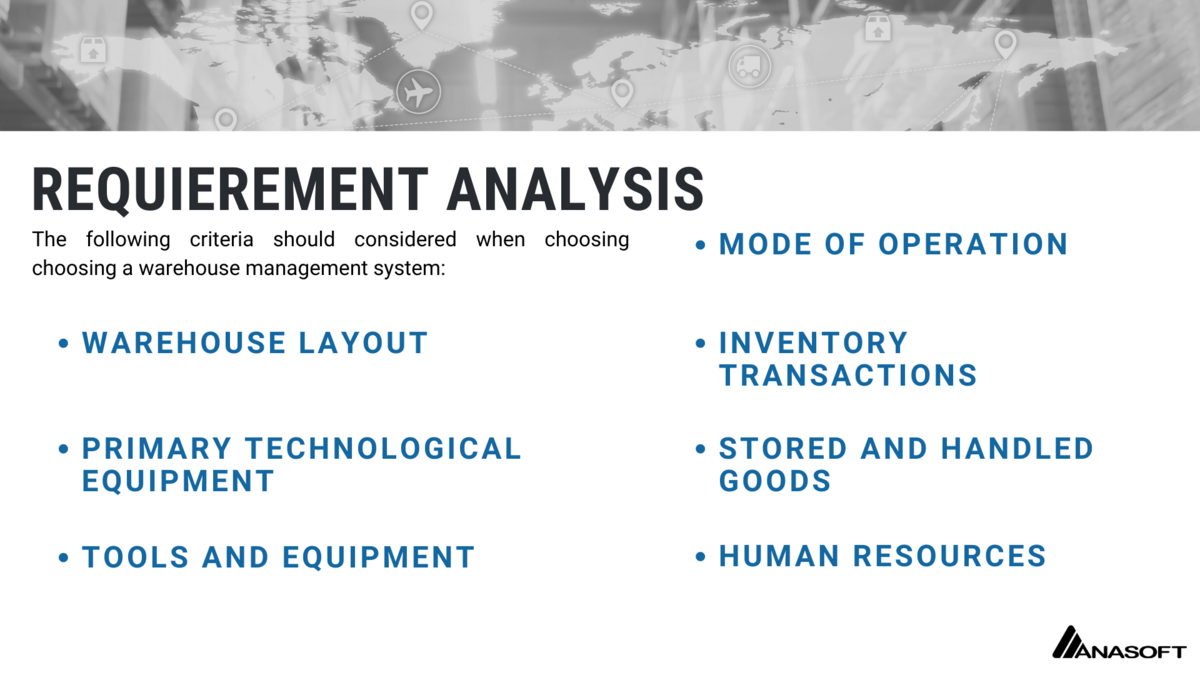
Selecting the most suitable WMS system should be preceded by a thorough research phase including a detailed analysis of the environment into which the system is to be deployed. The warehouse or the shop floor, its spatial arrangement and dimensions, as well as the diversity of stored items – these all define the basic parameters and functionalities of the new WMS system.
Therefore, it is appropriate to focus first on the following criteria during the analysis:
Warehouse layout:
- the current or planned spatial layout of the warehouse,
- its division into zones (including the reason for such division),
- the number and location of stock zones (horizontal, vertical, aisles, racks, shelf, bins);
Primary technological equipment:
- available or planned material handling equipment
- and other warehouse machinery (sorters, conveyor belts, packaging technology, forklifts, etc.);
Tools and equipment:
- available scanning devices,
- and measuring tools (barcode readers, RFID scanners, digital scales, etc.);
Expected inventory to be stored and handled:
- type,
- quantity,
- variety of packaging,
- inventory turnover forecasts;
Movement in the warehouse:
- how much,
- how often,
- the structure of incoming inventory (for putaway and storing),
- the composition of orders for picking and dispatching operations;
Human resources:
- structure,
- size,
- tasks,
- and responsibilities of shop-floor staff and management;
Mode of operation:
- work shifts,
- schedule of individual warehousing,
- and inventory processes.
The analysis should give answers to the business´s expectations and priorities, such as what prevailing issues should be eliminated, what goals the company seeks to achieve, or what added value should be generated. All these circumstances have a major impact on the scope of functionality of the future WMS system. In many cases, the basic functions of the WMS system may no longer be sufficient to achieve business goals.
If the warehouse is divided into different storage zones (for example, due to the different conditions required for stored inventory), the WMS system should be able to sort the incoming inventory according to target storage zones during the receiving process.
On the other hand, the function of parallel zone picking could be beneficial in a warehouse of this type, as it allows orders to be decomposed into several picking lists. More pickers can work on voluminous orders in different storage zones simultaneously and thus accelerate the order-picking process and delivery time.
When a business is handling sensitive stock like food or pharmaceuticals, the WMS system must offer an augmented monitoring of the stock's key attributes. These attributes, such as the batch number, expiration date and country of origin, directly affect the processual rules for the individual warehouse movements and transfers.
Another distinct warehouse feature is omnichannel logistics. In such cases, multi-level storage positions are often used in warehouses to store a single SKU. One position may serve to store inventory in transport packaging, another may hold wholesale inventory packages (for B2B orders) and yet another can be used to store inventory in pieces solely for B2C orders.
Based on the quantity of items in an order, the WMS system navigates picker to the relevant position – depending on whether the order is for a B2B client, retail customer or consumer ordering directly from the online shopping platform.
Extending warehousing capacity, usually by growing the number of order pickers in warehouse zones, never resultss in the desired improvement in warehouse productivity. In such cases, the function of mirroring stock positions (SKU mirroring) offers better results.
This functionality of advanced WMS systems allows the placement of high turn-over goods into an array of suitably located storage positions, thus eliminating clashes between order pickers in zones or near warehouse positions.
WMS developers and vendors usually employ experienced professionals who can help with warehouse or logistics analysis. They can help to accurately identify demands for warehouse and logistics processes to maximize order fulfillment productivity and warehouse efficiency (reducing operations expenses, eliminating waste and downtime) and offer best practices tailored for each business´s unique requirements or aspirations.
MANAGEMENT OF CORE WAREHOUSE PROCESSES
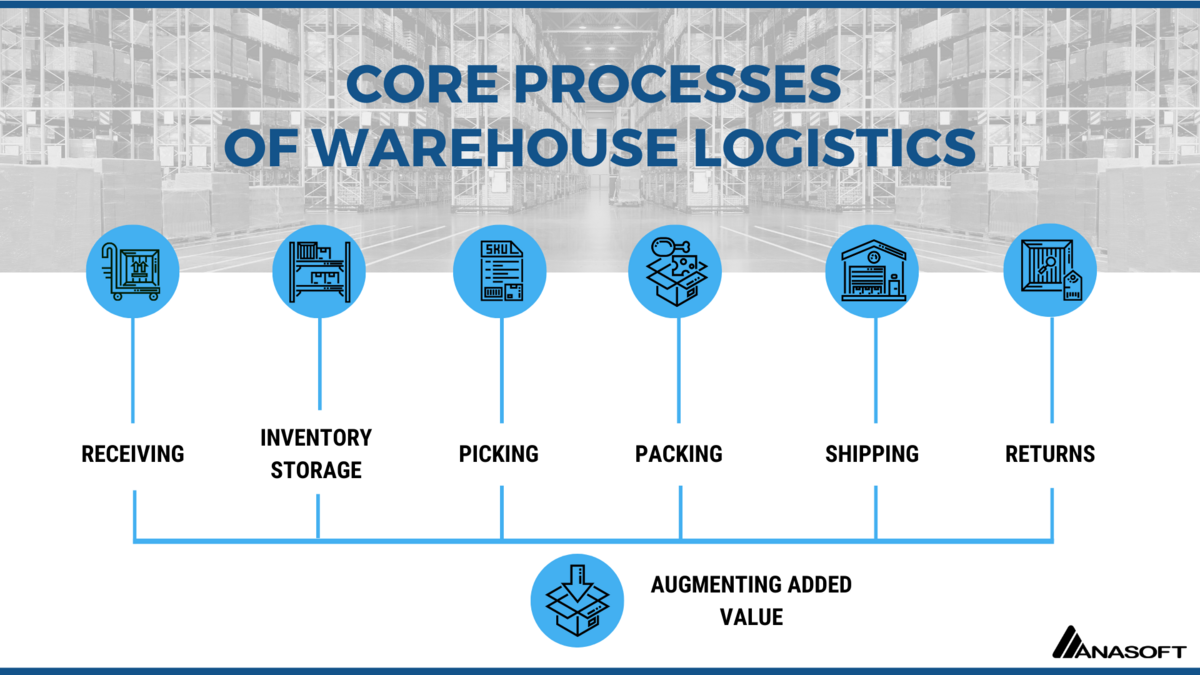
WMS systems were originally designed to better organize inventory management and provide an overview of stock levels. However, these systems have evolved considerably through successive generations.
Today, most warehouse software has inventory management functionality (or modules) embedded, along with functions or modules for planning, scheduling and management of warehouse staff and pickers (labor management).
The warehouse system to be implemented should therefore be able to ensure the smooth operation of all inventory and logistics processes:
- from the incoming goods receipt to order dispatching,
- balancing and replenishment of stock,
- and warehouse task interleaving.
The process analysis should be one of the key documents used in the selection a new WMS system. A thorough analysis of core processes, in particular their capacities and performance, will help to identify existing or potential issues (regarding e.g. down-time, change-over, bottlenecks) that the new system could rectify.
Furthermore, the implementation of a new WMS system almost always involves a revision of existing warehouse processes and their subsequent reorganization. Warehouse and logistics staff can help identify risk elements or routine activities that can be optimized or effectively automated.
The new WMS system can generate added value even if the business does not plan to make large investments in new material handling automation technology, simply by automating and accelerating selected decision-making processes.
Companies utilizing the same material handling units for inventory receipt, order picking and dispatch can benefit from task interleaving. This functionality enables businesses to intelligently combine picking and putaway in a single trip through the warehouse, greatly augmenting their productivity.
Each warehouse is different, and this means individualized approaches to order picking lead to better KPIs. The traditional discrete picking – one picker is always picking a single order grabbing, an item line by line before moving to next order – is recommended for smaller warehouses.
Medium to larger warehouses storing a wider portfolio of inventory, however, may achieve better performance by opting for a zone picking strategy. The biggest advantage of zone picking is the possibility of simultaneous jobs being performed by several pickers on the same order, thus dramatically shortening the order picking time.
The functionality of the WMS system to manage such a complex process is based on intelligent algorithms that coordinate a number of synchronously prepared orders with effective allocation of tasks to available staff.
Warehouses dispatching large quantities and volumes of orders, especially in the e-commerce sector, need to effectively utilize available human resources. One solution to optimize warehouse process dispatch is intelligent job clustering.
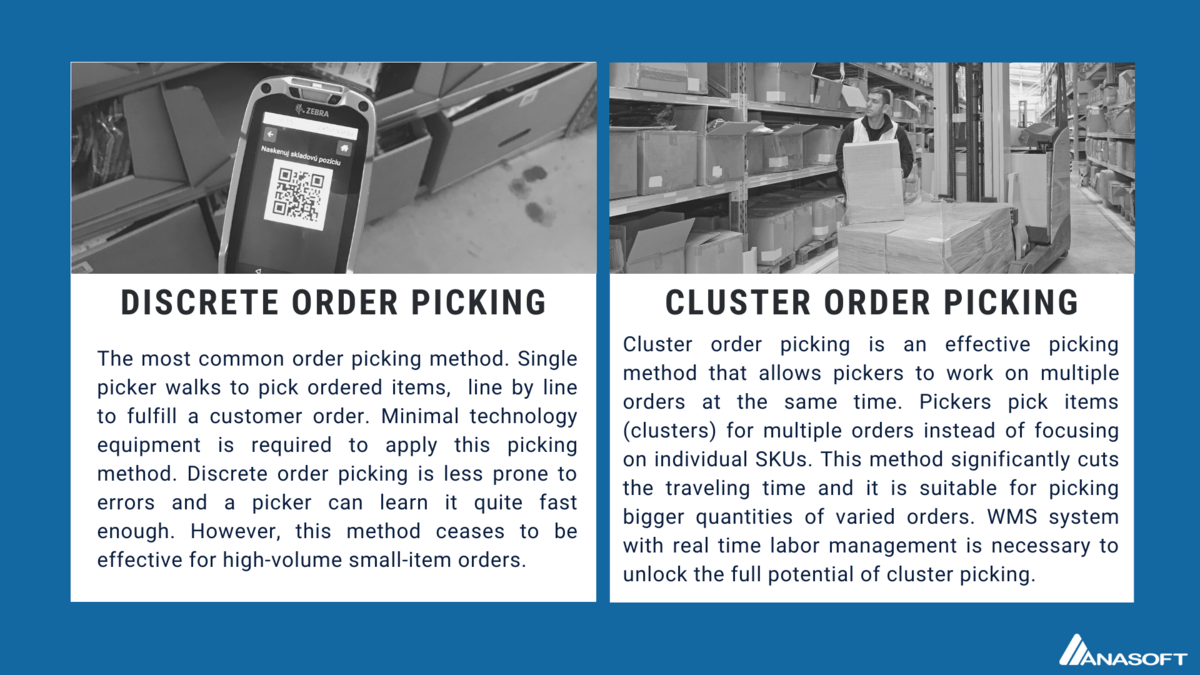
Automatic algorithms group items from orders into a single batch (cluster) picking list. Items for a single picker are based either on their similarity or location (clusters are created from items stored near each other).
The entire cluster pick is then assigned to a single operator who picks items for multiple orders simultaneously with other pickers in a single trip through the warehouse. The benefit of the cluster picking strategy is not solely the bulk of orders that can be picked, but the acceleration of the entire process due to the optimization of pickers’ routes in the warehouse. The same strategy can be applied to receiving and putaway processes.
Warehouses with multi-level storage keep stocked inventory and long-term reserve stock separated. In warehouses supplying material to manufacturing shop floors, the process of timely stock replenishment on production and assembly lines is crucial. Warehouse management systems provide several functions to best serve manufacturing cycles.
The traditionally practiced reporting of requests to deliver material upon visual inspection on the assembly can be replaced by automatically generated requests. Notifications for material delivery are triggered at the moment the levels of inventory in the shop floor fall critically low.
An advanced WMS provides a real-time overview of stock levels thanks to its detailed tracking capabilities. The system can automatically respond to low stock to ensure timely replenishment.
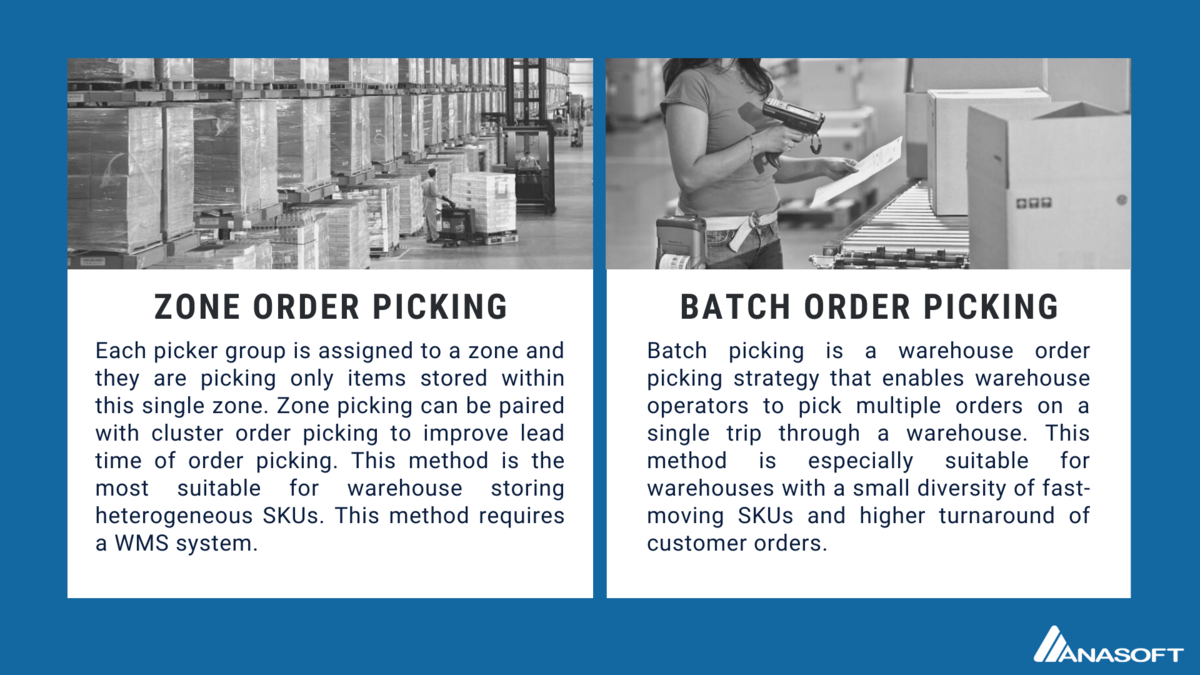
Businesses should pick key warehousing and logistics processes they plan to optimize and define parameters fitting their operation model and strategy when choosing a new warehouse management system – for example:
- time from receiving order to shipping,
- speed of response,
- efficient use of warehouse capacity,
- or human resources, etc.
Businesses planning to grow and scale up their operations should concentrate primarily on agile and modular WMS systems.
OPERATIONS RESILIENCE AND HANDLING THE DEMAND OF PEAK SEASONS
Today’s turbulent economy brings an abundance of hitherto-unprecedented situations to every business. Warehouse planning is no longer simply a matter of peak seasons which companies can anticipate and prepare for. The agility of an enterprise’s business models and operational processes is quickly becoming a requirement for business resiliency and growth.
The abovementioned criteria for choosing a new WMS acquire a new dimension if a business is operating in a mercurial environment of changing consumer patterns, economic situation, crises and other emergency events.
Equally important, however, is the correct adjustment of the company´s internal processes – planned exponential growth and continuous improvement on the one hand, and on the other hand high labor turnover or frequent mistakes due to human error.
Dynamically changing circumstances of business environment and expected shifts in operating parameters (holiday peaks) motivate companies to seek more complex solutions for inventory and supply management and warehouse logistics. A warehouse management system’s capability to make predictions and forecasts based on data from previous periods or to autonomously react to changes are becoming priorities when implementing a new WMS.
The best-known example of such a function is dynamic warehouse slotting optimization. In contrast to fixed slotting, WMS allocates high-turnover goods to slots near the shipping area in order to reduce handling time. The system dynamically reconfigures slots in the warehouse based on the analysis of goods turnover and their movement to trim the time of putaway and pick operations, avoid loss of goods, improve the workplace ergonomics of warehouse staff and ultimately cut warehouse operating costs. This capability particularly benefits companies facing impactful fluctuations in the turnover of inventory/goods, such as consumer electronics, clothing, household goods or groceries.
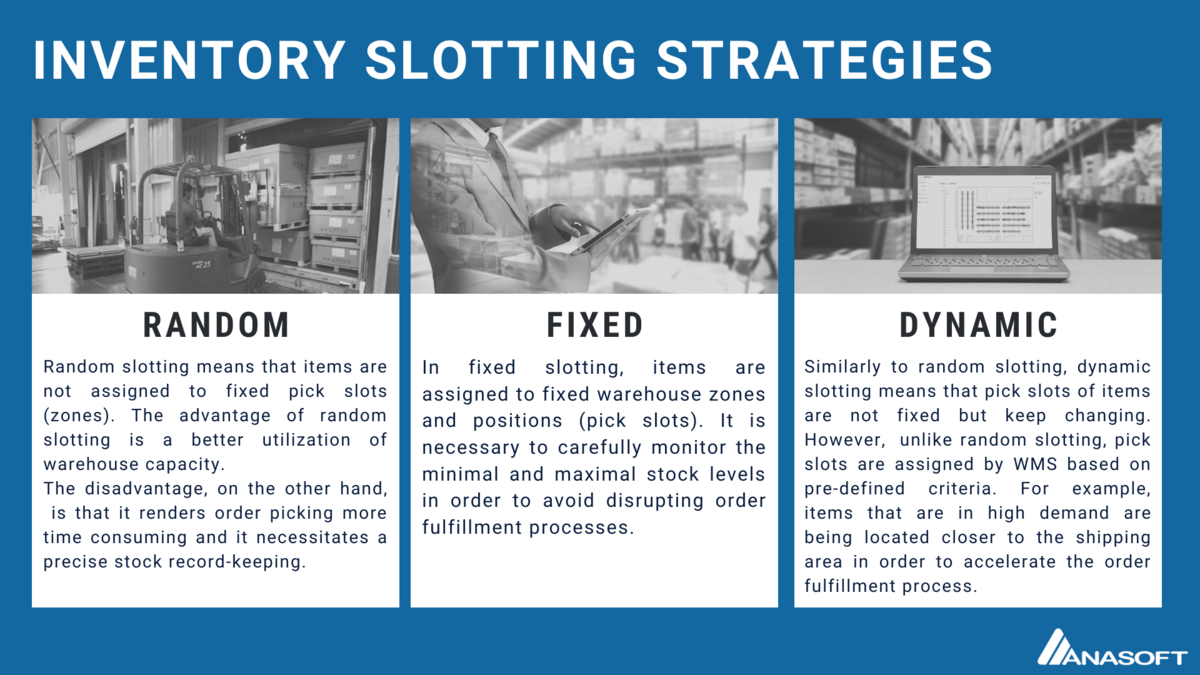
A similar functionality, which businesses handling fast-moving consumer goods will appreciate, is demand-driven re-allocation of slots and stock replenishment. The WMS automatically re-allocates stored goods to more advantageous slots (and/or assures replenishment of the current slot).
The impetus for re-allocation (or replenishment) is either a recorded demand for the item or a prediction of increased demand. These operations are carried out during periods of lowest warehouse utilization to avoid obstructing standard order fulfillment processes.
Among the additional functions to consider when selecting a new WMS is cartoning and palletization of goods. The purpose of cartoning (a packaging function) is to intelligently determine the optimal size of the package for the delivery based on the dimensions and quantity of items grouped in individual orders.
A similar approach applies to palletization, i.e. the identification of a suitable grouping and efficient storage of individual packages on a storage and transport units (usually a pallet). Both functions result in a drastic reduction of dispatching and transport expenses.
Warehouse slot optimization, cartoning and palletization, among other functionalities of a modern WMS, are often governed by leading technological tools, sometimes at the level of a specialized artificial intelligence (AI). Businesses are demonstrating growing interest in these technologies, which are poised to become a norm in warehouse operations in the coming years.
INTEGRATION WITH WAREHOUSE AND LOGISTICS EQUIPMENT
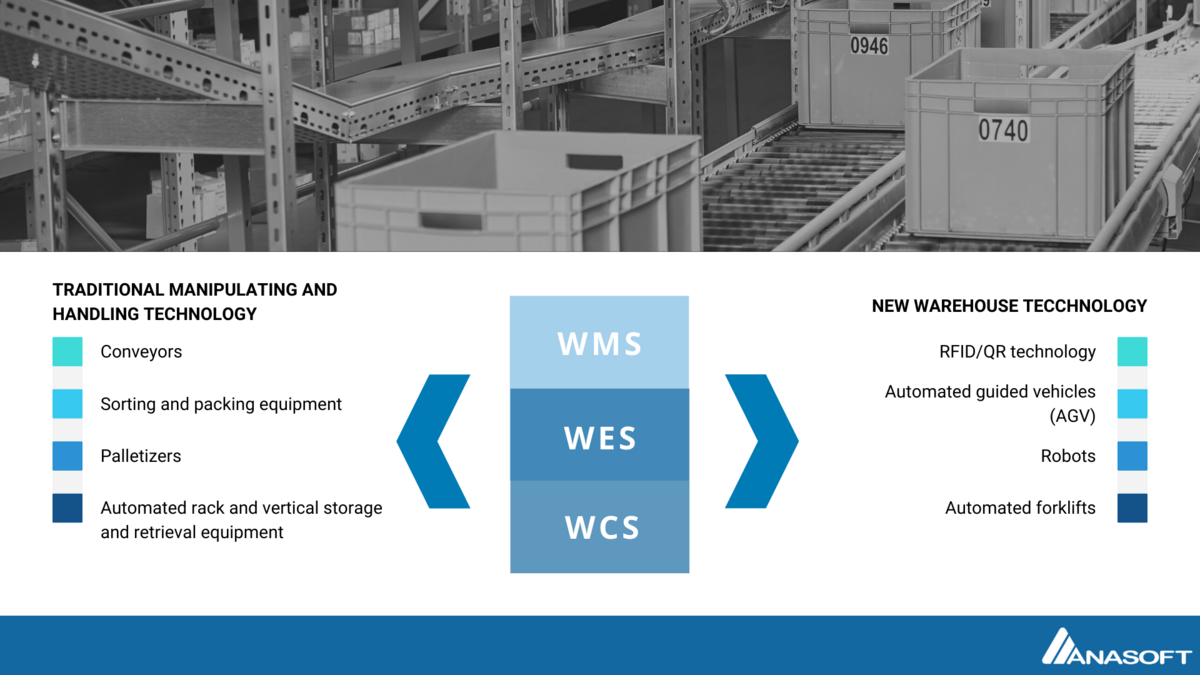
When a company chooses a WMS, the software should take into account the focus and structure of the company. Furthermore, the system should allow connectivity (a smooth integration) of the equipment that the company uses or plans to use in warehousing and logistics.
First and foremost, the WMS should entail an optimal management of slots and zones, including communication with:
- barcode readers,
- RFID scanners,
- digital scales,
- and other scanning and measuring devices.
However, if a company is considering automating processes or operations, it should consider implementing a more complex WMS solution. Larger innovation and automation projects usually entail more advanced logistics technologies, such as:
- automatic sorters,
- warehouse packaging machinery,
- palletizing equipment,
- conveyor belts,
- carousels,
- robots,
- automated storage and retrieval systems,
- or automatically controlled vehicles (AGVs).
Therefore, when preparing an extensive innovation project, the company should keep in mind that the future warehouse software needs to be able to manage and synchronize various warehouse and handling technologies.
While most standard warehouse management systems are designed primarily for inventory, material and labor management, management of warehouse technology and equipment is usually in the domain of warehouse control systems (WCS).
However, WCS systems are usually specific to implemented equipment or its technological suppliers. For this reason, companies should consider implementing more modern management software when preparing larger automation projects involving deployment of a variety of equipment and technologies.
Intelligent warehouse solutions tend to combine the functionalities of both systems – WMS and WCS. They are usually referred to as warehouse execution system (WES), the warehouse and logistics equivalent of manufacturing execution systems (MES). These systems introduce a higher degree of dynamization to operations management in warehousing and logistics.
WES systems regard warehousing, inventory and logistics processes as events, i.e. as tasks that need to be planned, allocated and managed. This approach opens up new possibilities for optimization of warehouse operations, as well as their advanced integration with other processes within the material flow (manufacturing, quality control, external transport).
Modern WES solutions belong to the category of progressive smart industry systems. Their common feature is a decentralized architecture and the utilization of new technologies based on the Internet of Things (IoT) and the Internet of Services (IoS).
The main advantage of the Internet of Things (IoT) is its ability to interconnect physical objects, technological equipment and software. The speed of digital information transfer and the ability to process a large volume of information in real time predispose smart industry solutions for intelligent, dynamic and autonomous operations management in supply chain and logistics.
INTEGRATION WITH FINANCIAL AND ADMINISTRATIVE SYSTEMS
The average inventory accuracy threshold for retail operations is only 63%
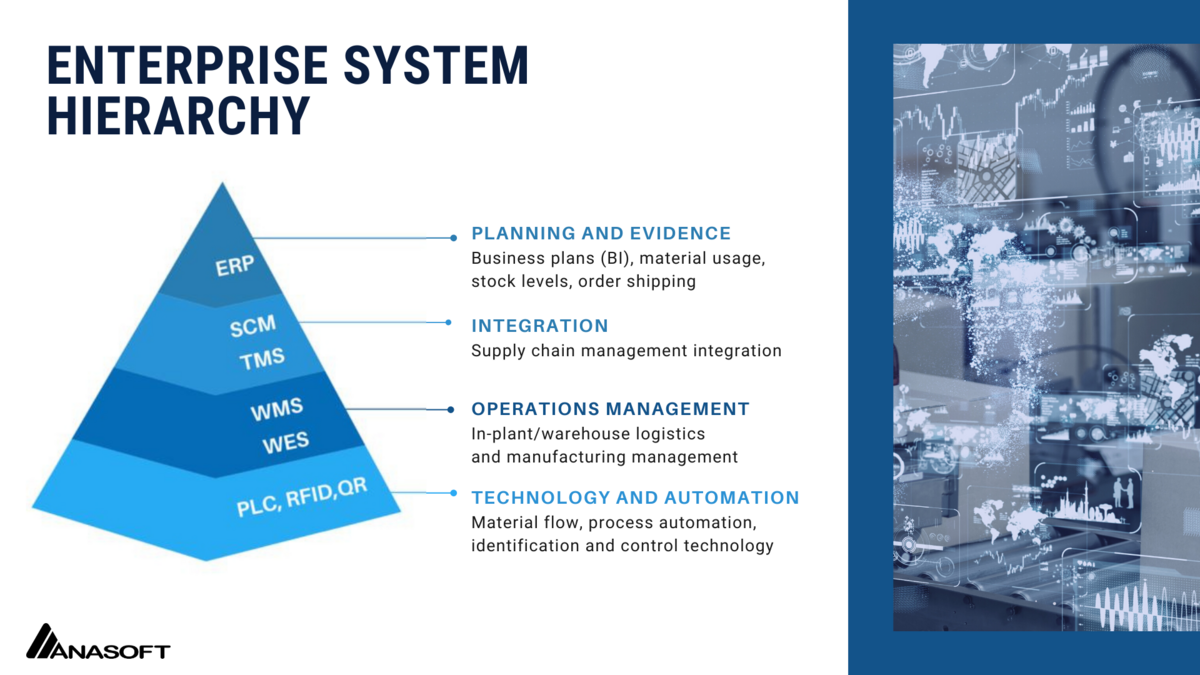
Another parameter that must be taken into account when choosing a new WMS is its compatibility with systems that are already deployed in the company´s operations, usually ERP systems.
The company needs to have access to up-to-date information on stock, turnover of goods and incoming orders, as well as on picked and dispatched orders. It is not possible to effectively run warehouse and logistics operations without correct and accurate data.
In the case of integrating the new WMS system with other enterprise software, agendas and information need to be divided among all the systems in order to ensure smooth data transfer. At the same time, the competencies of all systems employed for warehouse operations need to be clearly distinguished.
The purpose of distinguishing scopes of all systems involved is to ensure accurate and consistent data management. That means, for example, that only one of the systems should be responsible for recording stock movements in slots or for keeping records of warehouse operators.
In general, the role of the ERP system focuses on accounting operations, supplier-customer relationships, monitoring and evaluation of the financial value of inventory and the management of basic records of the company's resources (people, machines, goods).
The task of the WMS system, on the other hand, is to track and evaluate warehousing and order fulfillment operations in terms of exact quantities, specific storage location or slot localization, planning and dynamic management of labor and monitoring (and reporting) of relevant information.
The correct integration of both systems – ERP and WMS – is also the right way to dematerialize warehouse operations and shift toward becoming paperless. If a company utilizes other management systems, such as yard management systems (YMS) or transport management systems (TMS), the new WMS’s compatibility and potential to integrate with these systems must be carefully considered.
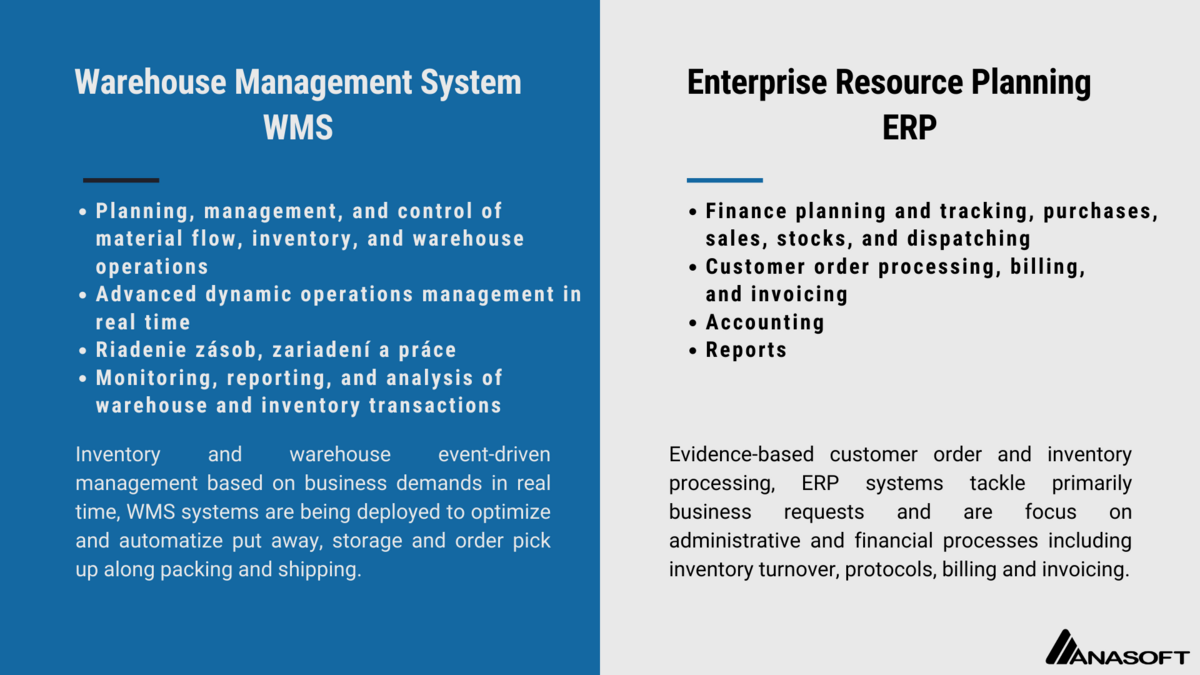
USER EXPERIENCE AND WORKPLACE ERGONOMICS
Deployment of a WMS system entails formalization and standardization of already established warehouse operations, which in general leads to their partial optimization and the reduction of erroneous actions. Another way to increase the optimization potential of an innovation project is to deploy a WMS system with a simple and intuitive user interface. Thanks to clear and accurate information available to warehouse staff, workflow becomes smoother while curtailing downtime and ineffective actions.
At the same time, better transparency associated with the tracking of individual operations leads to more correct task fulfillment. Such digital Poka-Yoke (inadvertent error prevention, “mistake-proofing”) significantly enhances the quality of performed tasks in terms of the correctness of the picked goods in orders, the optimized ordering of orders (products) for deliveries with time limits or the correct sorting of packages for dispatching.
Standardization of processes in combination with the simple user interface of the WMS contributes to an accelerated onboarding of new employees and a more productive engagement of the workforce. Such capability results in more flexible human resource management (labor management), especially for seasonal workers or during peak periods.
Moreover, modern WMS systems take into account parameters of ergonomic labor management. The system reorganizes items in picking lists (based on parameters like weight or size) to eliminate excessive and unnecessary bending, handling of heavy items, or moving inventory around the warehouse. This functionality can protect staff health, contribute to workplace safety and provide labor comfort.
MODULARITY AND CONTINUOUS INNOVATION
96% of executives identify innovation as "extremely important" to growth
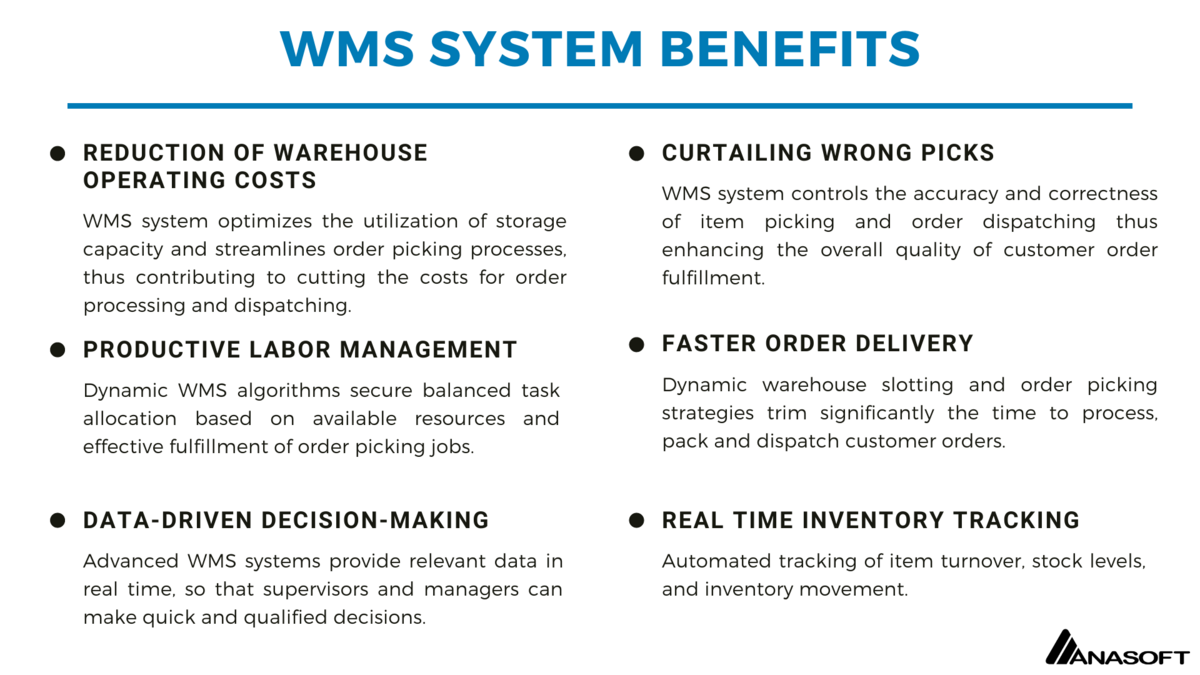
The most important decision a company faces when choosing a new WMS is whether to choose a ready-made (and ready-to-deploy) product or opt for a tailor-made solution. A ready-made WMS is usually the cheapest choice but comes at the cost of reshaping warehouse operations and processes to suit the predefined basic functionality of the WMS.
On the other hand, a tailor-made WMS solution is developed and fine-tuned to all relevant processual and technological parameters and idiosyncrasies of the warehouse. Ideally, the custom-made solution generates added value by enhancing the company's competitiveness through invigorating the operational strategies and models of the company's unique know-how. However, the main disadvantages of such a solution are its higher cost and longer development time.
Compromise between the two types of software can usually be found in a modular WMS system. Modular warehouse software has pre-prepared (pre-developed) core processes, whereas the remaining operations are open to be tweaked according to the unique parameters of the warehouse. This option leads to improvement of standard warehouse processes and optimization of specific operations both in the warehouse and beyond it.
A modular WMS solution allows companies to tinker with processes in the warehouse (or on the shop floors) and continuously fine-tune and innovate their operations. After the initial warehouse software implementation, companies can continue to optimize individual operations. Warehouse and supply operations can be modified whenever the need emerges or a better operational strategy is found.
At least partial openness (scalability) of a WMS and its modularity are beneficial from the long-term perspective, especially if a company is planning further growth and operations development. In addition, a modular and scalable WMS enables the company to maintain operational sustainability as it can flexibly retool and adapt warehousing processes in unprecedented circumstances or new business conditions.
Following shifts in the market or in customer patterns, a company may be forced to alter its original market segment of B2B to the end-consumer market, i.e. the B2C segment. Companies in this situation will appreciate more agile WMS systems, as they allow for near-immediate adjustment when operational models or business strategies change.
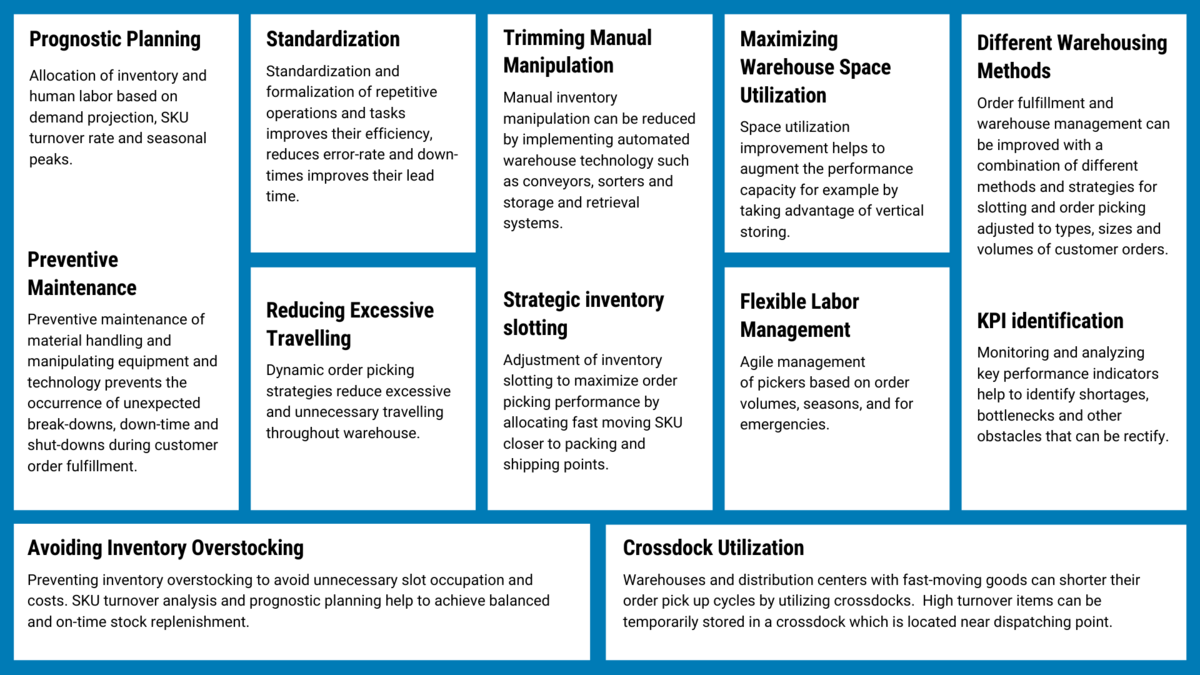
The right WMS and accurately tuned process optimization will ultimately result in a shorter return on investment. This will allow the enterprise to further automate warehousing and logistics processes, scale up digitalization and proceed to more ambitious innovation projects, especially if the company is planning strategic expansions into new markets or territories. With the increasing functionality provided by a WMS system, a company can generate substantial added value, which has a direct impact on the reduction of operating costs and on the overall efficiency of warehouse operations.
read more







